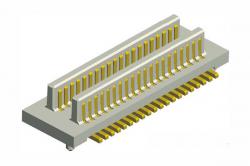

0.5mm Board to Board Male Double Contact Type
- Part No : BBP05D-XXG-240
-
Specifications:
1. Current Rating : 0.5A AC/DC
2. Voltage Rating : 50V AC/DC
3. Contact Resistance : 30m ohm. max.
4. Insulation Resied stance : 100M ohm. min.at 100V DC
5. Withstanding Voltage : 100V AC for one minute
6. Operating Temperature Range : -40°C ~ +105°C
Merial and Plated
1.Housing :High Temp. Plastic (LCP UL94V-0)
Color :White
2.Contact : Phosphor Bronze
3.Plated : Gold Plated - Inquiry now
- Products Drawing Products Drawing Products Drawing
Detailed description
PCB board-to-board connections are essential in modern electronic design and manufacturing.
Contact:Catherine Tang
Mobile/WhatsApp:+18692238587
Here are some key aspects of PCB board-to-board connections:
-
Physical Connection: PCB board-to-board connections are established through the use of electrical connectors, such as pin headers, sockets, mezzanine connectors, and more. These connectors have male and female components that mate to create a secure electrical pathway.
-
Interconnection Purpose: The primary purpose of these connections is to enable the exchange of electrical signals, data, and power between interconnected PCBs. Depending on the design and application, these connections can serve various functions.
-
Signal Integrity: Maintaining signal integrity is critical in PCB board-to-board connections, especially in high-speed data transmission applications. Proper impedance matching, shielding, and careful design are essential to minimize signal degradation.
-
Space Efficiency: Designers aim to optimize the use of PCB real estate and ensure that board-to-board connectors do not interfere with other components on the PCB.
-
Versatility: PCB board-to-board connections come in a variety of configurations, sizes, and pitches to accommodate different design requirements and applications.
-
Applications: These connections are used in various electronic devices and systems, including consumer electronics, industrial machinery, automotive systems, telecommunications equipment, and more.
-
Customization: Designers often have the flexibility to customize the type of connectors, pitch, and configuration to suit the specific needs of their electronic designs.





